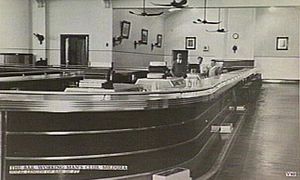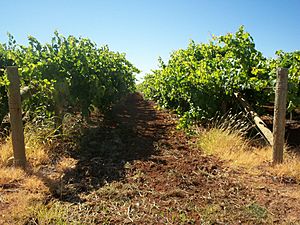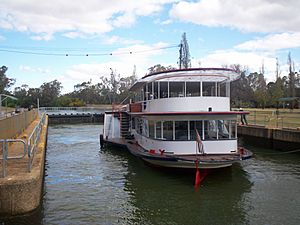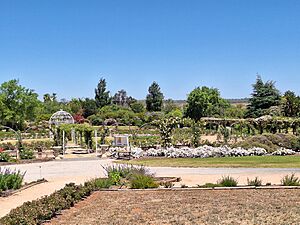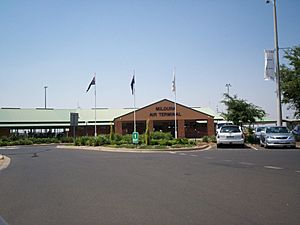Mildura facts for kids
Quick facts for kids MilduraVictoria |
|||||||||||||||
|---|---|---|---|---|---|---|---|---|---|---|---|---|---|---|---|
|
Deakin Avenue, Mildura's main street.
Langtree Avenue
Mildura Vineyards
Lock 11
George Chaffey Bridge
|
|||||||||||||||
| Population | 34,565 (2021 census) | ||||||||||||||
| • Density | 446.00/km2 (1,155.1/sq mi) | ||||||||||||||
| Established | 1887 | ||||||||||||||
| Postcode(s) | 3500 3502 (PO Box) |
||||||||||||||
| Elevation | 51 m (167 ft) | ||||||||||||||
| Area | 77.5 km2 (29.9 sq mi) | ||||||||||||||
| Time zone | AEST (UTC+10) | ||||||||||||||
| • Summer (DST) | AEDT (UTC+11) | ||||||||||||||
| Location | |||||||||||||||
| LGA(s) | Rural City of Mildura | ||||||||||||||
| Region | Sunraysia Loddon Mallee |
||||||||||||||
| County | Karkarooc | ||||||||||||||
| State electorate(s) | Mildura | ||||||||||||||
| Federal Division(s) | Mallee | ||||||||||||||
|
|||||||||||||||
|
|||||||||||||||
Mildura is a city in north-west Victoria, Australia. It sits right on the Murray River, which is a very important river in Australia. In 2021, about 34,565 people lived in Mildura. If you include nearby towns like Wentworth and Irymple, the total population for the urban area was about 58,914 people.
Mildura is the biggest town in the Sunraysia region. This area is famous for growing grapes. About 90% of Australia's table grapes (grapes you eat) for export come from here. Mildura also produces about 80% of all grapes in Victoria, including those for wine and dried fruit. The city is very close to the New South Wales border. It gets lots of water for farming from the Murray River. Mildura was even known as Australia's first 'irrigation colony' because of how it used river water for farming.
The city's main shopping and dining area is along Langtree Avenue. Part of this street is a pedestrian mall, meaning only people can walk there, not cars. Another big shopping area is on Fifteenth Street. The name Mildura comes from an old sheep station that used to cover the area. The city is surrounded by farms that grow grapes and citrus fruits, all watered by the Murray River.
Contents
- Mildura's Past: A Look at History
- Mildura's Landscape and City Layout
- Mildura's Weather
- Mildura's Economy: How the City Makes Money
- Mildura's Culture and Arts
- Who Lives in Mildura: Demographics
- Famous People from Mildura
- Media in Mildura
- Sports in Mildura
- Getting Around: Transport in Mildura
- Learning in Mildura: Education
- Sister Cities
- See also
Mildura's Past: A Look at History
Mildura has a long history of growing oranges and grapes. Even before that, it was home to Aboriginal people for thousands of years. The Latje Latje and Ngintait peoples were some of the first inhabitants of the Mildura area.
What Does the Name Mildura Mean?
No one is completely sure where the name Mildura came from. It was the name of a sheep station, but many historians think it came from Aboriginal words. In different local languages, the words mill and dura have different meanings. Dura usually means "earth," "sand," or "rock" in the local Ladji Ladji language. But mill could mean "red" or "water." So, Mildura might mean "red earth" or "water rock."
Early Days: Aboriginal People and European Settlers
Many Aboriginal people lived around Mildura because there was plenty of food. The Latjilatji and Jarijari tribes were among them.
The first Europeans arrived in 1857. They brought sheep to graze on the rich land.
How Irrigation Changed Mildura
A big drought happened in Victoria from 1877 to 1884. This made Alfred Deakin, who was a government minister, visit California to see how they used irrigation (watering crops). There, he met two brothers, George and William Chaffey, who were experts in irrigation.
In 1886, George Chaffey came to Australia. He chose an old sheep station called Mildura to start his first irrigation settlement. He made a deal with the Victorian government to spend a lot of money on improving Mildura over the next twenty years.
After some discussions, the Mildura settlement was officially started in 1887. The Post Office opened soon after, in January 1888.
How Mildura Grew Over Time
Other towns nearby, like Wentworth and Gol Gol, also started around the same time. In the 1890s, rabbits became a big problem for sheep farmers. There was also a financial downturn. These things slowed down Mildura's growth for a bit.
But after this tough period, Mildura started to grow quickly. It became the main town in the area. New suburbs and towns popped up around it. By 1934, Mildura was officially called a city.
After World War II, many people moved to Mildura, especially from European countries like Italy and Greece. They came for jobs in the fruit picking industry.
World Hot Air Ballooning Championships
In 2004, Mildura hosted the 16th World Hot Air Ballooning Championships. This brought many visitors to the city.
Mildura's Landscape and City Layout
The Land Around Mildura
Mildura is built on flat land on the southern side of the Murray River. It's surrounded by lakes and billabongs (small lakes or ponds) like Lake Hawthorn. Other towns like Merbein and Irymple are nearby. These can feel like suburbs or smaller towns separated by farmland.
While the land near the river is very fertile for farming, much of the area around Mildura is dry and semi-desert.
How the City is Built
Mildura is mostly made up of low buildings and spread-out homes. Most people use cars to get around. Homes are usually single-family detached homes with good-sized yards. The city has been growing fast, with new homes being built in the south, southwest, and east.
The main part of the city, called the central business district (CBD), is near the Murray River. Langtree Avenue is the main shopping street, with a pedestrian mall and shops. The area between Seventh and Eighth Streets is called Feast Street, known for its restaurants. The Mildura Central Shopping Centre is another big shopping spot. Deakin Avenue, named after Alfred Deakin, is a very long street, about 12.1 kilometres! It runs from the city centre into the farmlands. Fifteenth Street has many large stores and car dealerships.
Some of the taller buildings include the Old Mildura Base Hospital and the Marina Dockside apartments. The 'new' water tower from the 1950s and the 'old' water tower are also important landmarks.
Mildura's Weather
Mildura has a cold semi-arid climate, which means it has hot summers and cool winters. It's only about 50 metres above sea level, even though it's far from the coast. Mildura gets about 132 clear days each year.
The city gets about 280 mm of rain each year, spread out fairly evenly. Winter and spring usually have the most rainy days.
In summer, the average high temperature is about 32°C (90°F). In winter, it's cooler, around 15°C (59°F). Night temperatures range from about 17°C (63°F) in summer to 4°C (39°F) in winter. Frost is common in winter and can sometimes harm crops. Mildura can have very hot days in summer, sometimes over 40°C (104°F).
In February 2011, Mildura had a record amount of rain in one day, with 155 mm (6.1 inches) falling.
| Climate data for Mildura Airport, elev. 50 m (160 ft), (1991–2020 means, extremes 1946–present) | |||||||||||||
|---|---|---|---|---|---|---|---|---|---|---|---|---|---|
| Month | Jan | Feb | Mar | Apr | May | Jun | Jul | Aug | Sep | Oct | Nov | Dec | Year |
| Record high °C (°F) | 46.9 (116.4) |
46.7 (116.1) |
42.5 (108.5) |
39.3 (102.7) |
29.6 (85.3) |
25.4 (77.7) |
27.1 (80.8) |
29.9 (85.8) |
37.7 (99.9) |
40.2 (104.4) |
45.7 (114.3) |
46.8 (116.2) |
46.9 (116.4) |
| Mean daily maximum °C (°F) | 33.3 (91.9) |
32.5 (90.5) |
28.8 (83.8) |
24.1 (75.4) |
19.5 (67.1) |
16.3 (61.3) |
15.8 (60.4) |
17.8 (64.0) |
21.2 (70.2) |
25.0 (77.0) |
28.5 (83.3) |
31.0 (87.8) |
24.5 (76.1) |
| Mean daily minimum °C (°F) | 17.4 (63.3) |
16.9 (62.4) |
13.8 (56.8) |
10.0 (50.0) |
7.2 (45.0) |
5.2 (41.4) |
4.4 (39.9) |
5.1 (41.2) |
7.5 (45.5) |
10.0 (50.0) |
13.1 (55.6) |
15.3 (59.5) |
10.5 (50.9) |
| Record low °C (°F) | 7.6 (45.7) |
5.2 (41.4) |
3.8 (38.8) |
0.6 (33.1) |
−2.1 (28.2) |
−3.7 (25.3) |
−4.0 (24.8) |
−3.1 (26.4) |
−1.1 (30.0) |
1.1 (34.0) |
3.3 (37.9) |
5.3 (41.5) |
−4.0 (24.8) |
| Average rainfall mm (inches) | 25.2 (0.99) |
23.1 (0.91) |
16.2 (0.64) |
16.8 (0.66) |
18.8 (0.74) |
20.3 (0.80) |
21.2 (0.83) |
21.6 (0.85) |
26.1 (1.03) |
24.8 (0.98) |
27.7 (1.09) |
31.9 (1.26) |
273.6 (10.77) |
| Average rainy days (≥ 0.2 mm) | 3.8 | 2.8 | 2.8 | 3.6 | 5.9 | 8.1 | 8.7 | 8.2 | 6.7 | 5.6 | 5.2 | 4.5 | 65.9 |
| Average afternoon relative humidity (%) | 25 | 27 | 30 | 34 | 46 | 54 | 52 | 42 | 37 | 30 | 27 | 25 | 36 |
| Mean monthly sunshine hours | 341.0 | 288.4 | 297.6 | 255.0 | 204.6 | 168.0 | 182.9 | 222.0 | 254.2 | 291.4 | 297.0 | 331.7 | 3,133.8 |
| Source: Australian Bureau of Meteorology (sun 1989–2017) | |||||||||||||
Mildura's Economy: How the City Makes Money
Growing Fruit and Making Wine
Mildura is known as the "Food Bowl" of Victoria. It produces a lot of citrus fruits, especially oranges, and is a major centre for wine. It also grows 80% of Victoria's grapes. Many wineries get their grapes from Mildura. The local area also produces over 70% of Australia's dried vine fruits, like sultanas.
Protecting Crops: The Fruit Fly Exclusion Zone
Mildura is part of a special "Fruit Fly Exclusion Zone." This means you can't bring certain fruits or vegetables into the area. This rule helps stop the Queensland fruit fly from getting into the crops. If these flies got in, they could cause huge damage to the farms and the economy. You'll find special bins along the highways where you can throw away fruit before entering the zone.
Tourism in Mildura
Tourism is a big business in Mildura, bringing in about A$210 million. Many visitors come to see friends or family.
Because Mildura is on the Murray River, it's a great place for water sports. You can also enjoy rides on old paddlesteamers and boat cruises. The calm weather makes Mildura perfect for hot air ballooning, and the Mildura International Balloon Fiesta attracts many people. The Australian Inland Botanic Gardens, located nearby, is another popular spot for visitors.
Mildura Central Shopping Centre
Mildura Central is the main shopping centre in the Sunraysia region. It's a large, enclosed, and air-conditioned mall. It has many national fashion stores and serves a large area, including people from Riverland and Broken Hill. Inside, you'll find big stores like Target, Woolworths, and Coles. Other popular shops include JB Hi-Fi and Jay Jays.
Mildura's Culture and Arts
Mildura has always been a home for artists, writers, and creative people. Groups like the Red Cliffs Musical Society and the Mildura Ballet Guild help local talent grow. The main place for arts is the Mildura Arts Centre. It started as a gallery in the 1950s and now has an art gallery and a theatre for performances. A new Mildura Arts Centre opened in 2012 after two years of building.
Mildura hosts many yearly festivals. Some popular ones include the Mildura Country Music Festival, the International Balloon Fiesta, the Jazz Food & Wine Festival, and the Mildura Writers Festival. There's also a fishing competition and a show for different types of wine.
Who Lives in Mildura: Demographics
In 2021, there were 34,565 people living in Mildura in 15,694 homes. About 5.5% of the people are Indigenous Australians. Most people (75.2%) were born in Australia. Other common birthplaces include Malaysia (2.6%), India (1.5%), and England (1.3%).
Most people (76.7%) speak only English at home. Other languages spoken include Mandarin (2.3%), Italian (1.4%), and Vietnamese (1.1%). When it comes to religion, 41.4% said they had no religion, 19.1% were Catholic, and 8.3% were Anglican.
Famous People from Mildura
Many notable people have come from Mildura, including:
- Leigh Adams: A retired motorcycle speedway rider who won many championships.
- Jason Akermanis: An Australian rules footballer who won the Brownlow Medal.
- Jason Crump: Australia's only three-time Speedway World Champion in motorcycle speedway.
- Ken Duncan: A famous Australian landscape photographer.
- Patricia Edgar: The founding director of the Australian Children's Television Foundation.
- Rick Kelly: A V8 Supercar driver who won the V8 Supercar Championship and the Bathurst 1000.
- Todd Kelly: Another V8 Supercar driver who won the Bathurst 24 Hour and Bathurst 1000.
- Matthew Knights: A former Australian rules football player and coach.
- Mark Lee: A premiership player for the Richmond Football Club.
- Ellen Sandell: A politician and environmentalist.
- Chris Tarrant and Robbie Tarrant: Australian rules footballers.
- Cam Waters and Josh Waters: Racing drivers.
- Julia Zaetta and Tania Zaetta: Well-known media personalities.
Media in Mildura
Mildura has local newspapers like the Sunraysia Daily. You can also find news online from sources like the Mildura Independent Star.
For radio, there's ABC Mildura Swan Hill (a national station), River 1467 AM, 97.9 Sun FM Sunraysia, and 99.5 Star FM.
Local TV channels include ABC TV, SBS TV, Seven, and WIN Television. There are also many digital channels like 7two, 7mate, 9Go!, and ABC Kids.
The Sunraysia region was the first in Australia to switch off analogue TV broadcasts and move to digital TV.
Sports in Mildura
Mildura loves sports!
- Australian Rules Football: Mildura has three teams – Imperials, Mildura, and South Mildura – that play in the Sunraysia Football League. There's also a junior league for younger players.
- Cricket: The Sunraysia Cricket Association (SCA) runs cricket games from October to March.
- Rugby League: The Sunraysia-Riverlands Rugby League has six senior men's teams that play from May to September.
- Motorsports: Mildura is famous for motorsports. It has tracks for Go-Kart racing, automobile speedway, motorcycle speedway (Olympic Park Speedway), drag racing, and off-road motorcycle racing.
- Swimming: Mildura has six swimming clubs, and competitions are held regularly in summer. Many swimmers from Mildura have become state and national champions.
- Baseball: The Sunraysia Baseball League plays in autumn and winter with four clubs. There are junior, senior, and women's competitions.
- Basketball: Basketball is very popular, with hundreds of teams in the Mildura Basketball Association's summer league.
- Soccer: Soccer also has a big following, with a junior and senior league played in winter.
- Field Hockey: Mildura has four field hockey teams that play in the Sunraysia Hockey Association, with grades for all ages and genders.
- Roller Derby: Mildura has its own roller derby league, the Mildura Roller Derby League, which competes around Victoria.
- Horse Racing: The Mildura Racing Club holds about nine horse races a year, including the Mildura Cup. The Mildura Harness Racing Club also has regular meetings.
- Golf: Golfers can play at the Mildura Golf Club.
Getting Around: Transport in Mildura
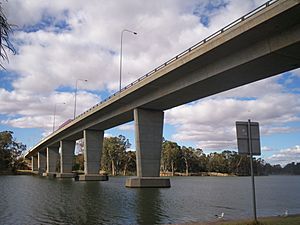
Mildura is located where two major highways meet: the Sturt Highway (from Adelaide to Sydney) and the Calder Highway (to Melbourne). Deakin Avenue, the main street, is known as the longest straight avenue in Australia, stretching for 12.1 kilometres. Bus services connect Mildura to other parts of Victoria and New South Wales. You can also catch buses to Adelaide and Sydney.
Mildura has a railway line to Melbourne, mainly used for freight (carrying goods). This line was upgraded in 2006.
Mildura Airport is the third busiest regional airport in Victoria. It has flights to Melbourne, Adelaide, Sydney, and Broken Hill. In 2023, a new airline called Bonza started flights between Mildura, Melbourne, and the Sunshine Coast.
Learning in Mildura: Education
St Joseph's College
In 1905, a group of Sisters of Mercy started a convent and began teaching in Mildura. Catholic secondary education officially began in 1906. The first buildings of St Joseph's College at its current location opened in 1929. The college has modern classrooms, science and computer labs, art facilities, a library, and sports areas.
Mildura Senior College
Mildura Senior College has been part of the city's growth since the 1880s. It started as Mildura High School in 1912. In 1990, it changed its name to Mildura Secondary College, and later to Mildura Senior College. Today, it focuses only on students in Years 11 and 12. In 2013, there were about 500 students in Year 11 and 400 in Year 12. Students who finish Year 10 can enroll here.
Chaffey Secondary College
Chaffey Secondary College is a state government high school for students in Years 7 to 10. In 2012, it had 640 students. The college offers many different courses each term. It has a large gymnasium that is also used by the Mildura Rural City Council, and a small theatre.
Sunraysia Institute of TAFE
The main campus of Sunraysia Institute of TAFE is on Benetook Avenue. TAFE colleges offer practical training for jobs. In 2008, 6,592 students were enrolled here.
La Trobe University
La Trobe University has a campus in Mildura. As of 2018, about 500 students were studying there.
Sister Cities
Mildura has "sister city" relationships with other cities around the world. These relationships help promote cultural exchange and understanding.
 Upland, California, United States: This city was also started as an irrigation community by the Chaffey brothers.
Upland, California, United States: This city was also started as an irrigation community by the Chaffey brothers. Kumatori, Osaka, Japan
Kumatori, Osaka, Japan Dali City, Yunnan, China
Dali City, Yunnan, China
See also
 In Spanish: Mildura para niños
In Spanish: Mildura para niños








